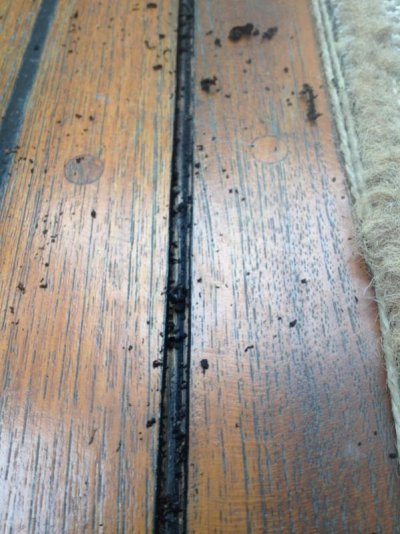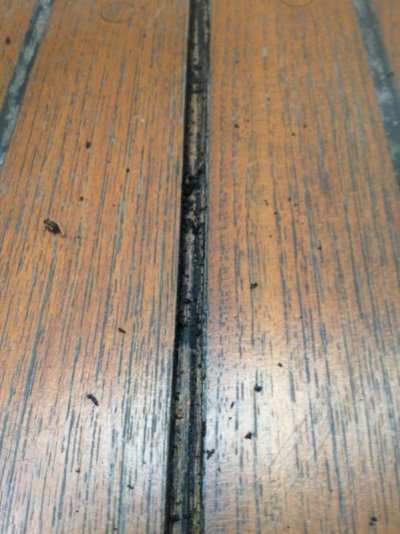Marin,
Great advice. Thanks. After discussing with the wife we are going to repair the seams and just let the CeTOL wear off We are gonna let it age gracefully. The deck is in great shape.
How do you maintain a grey deck? Salt water scrub against the grain?
First of all, it's not gray, it's silver.

I have never found the color ugly at all. In fact when I see a brown teak deck on anything but a new or covered boat, I think, "There is a teak deck that's going to have a shorter life than it should have" So to me, brown is an ugly color for a teak deck (other than the two exceptions I mentioned above) because I know what's happening to the teak and it ain't pretty.
Caring for a teak deck is actually no more difficult or time consuming than caring for a fiberglass deck. You simply need to keep it clean. The best way to do this is to wash it periodically--- the period being determined by how dirty your marina is--- with salt water and something like Lemon Joy. Lemon Joy is often recommended because it suds up very nicely in cold water.
We use a basic string mop on our our deck. This is gentle on the wood and does a great job of getting the surface dirt up.
Our marina is not the cleanest in the world because it holds a lot of boats, 2000-plus including a fairly active commercial fishing fleet. Also there is a small railyard next to the marina with one to three switch engines idling or operating every day, plus frequent--- every hour or so-- freight trains running past the marina on their way to or from the Vancouver, BC area. All of this stuff is putting soot into the air.
Boats do not turn black in a week or anything like that, but it doesn't take too long before a boat no longer passes the white glove test. Walking on the deck works this dirt down in the upper grain and the basic mopping may not get it out.
So a few times a year--- two or three at the most--- we "scrub" the deck using a "doodlebug" as it's called here, one of those woven fiber pads. This is when it's important to clean across the grain instead of with it except where deck hardware makes it impossible.
As we learned early on from teak experts, the reason is this:
Teak, perhaps like all woods, is composed of linear "runs" of soft and hard wood cells. The soft wood cells are quite soft and so are removed from the surface of the plank easier and faster than the runs of hard wood cells. Scrubbing with the grain with anything at all abrasive, even the doodle bug, will over time wear away the softer cells faster than the harder cells. The result will be a microscopic "valley" as the soft runs are worn away faster than the harder "ridges."
At first, this will be totally unnoticeable. But once this wear starts, it accelerates. Even the weather, if the boat is outside, will start wearing away softer cells. It will happen anyway over a lot of time, but you helping simply accelerates the wear.
Eventually this will result in visible grooves, or crevicing as the teak people call it. And this will get deeper and deeper with time. I'm sure you've probably seen this in older or weathered teak. We have some fairly severe crevicing in the teak platform of our bow pulpit and in a few of the boards on our port side deck. The only way to get rid of it is to sand the surrounding wood down and this is worse in the long run than living with and trying to minimize the continuation of the crevicing.
So, the less you can encourage the softer wood cells to go away the better shape your deck will stay in over time. That is why you should never scrub the deck with the grain, always across except in those places where structure makes this impossible, and the scrubbing you do should be very light pressure. You just want to remove that stubborn dirt, not any wood cells.
With a string mop or soft sponge, the direction is not so important as there is little to no real abrasion with these things.
But now perhaps you can understand why powerwashing, even at a low-pressure setting is ultimately devastating to a teak deck because even at low pressure it will start "blasting" those soft wood cells loose.
Pressure washing is also potentially damaging to the seam sealant adhesion to the side of the grooves. Seam sealant separating from one side of a groove or the other is how moisture gets down under the planks. All seams will do this eventually at which point the seam, or the entire deck if it's gotten really bad, will have to be re-seamed. But the easier you make life on the seams the longer the sealant will stay adhered to both sides of the groove, which is also why using bond-breaking tape in the bottom of the groove is essential to maintaining the adhesion of the seam sealant to the sides of the groove as long as possible.
I don't know if they use bond-breaking tape on the glued down decks manufacturers like Grand Banks, Fleming, etc. install today. A glued-down deck is much less flexible than a screwed down deck although the wood will still expand and contract with heat and humidity. But a screwed down deck, even though the planks were bedded in a fairly adhesive compound when they were laid, is actually quite "active" according to the experts we've talked to over the years. The planks can actually "squirm" a fair amount as the boat works, you walk on it, and heat and humidity act on the wood itself. So on a screwed-down deck, bond-breaking tape is pretty critical.
BTW, the reason you should use salt water when you wash your deck has nothing to do with teak liking salt water or anything like that. Salt water should be used because if there are any separated seam sides or missing deck plugs or less-than-perfectly bedded deck hardware, moisture will get down under the planks. And with a screwed down deck, with eighty-bazillion screws penetrating the fiberglass upper layer of the typical cruiser's fiberglass-plywood-fiberglass subdeck sandwich, this moisture can migrate down along a deck screw into the wood core. If it's salt water that's migrating down, this will hold rot at bay a lot longer than if it's fresh water.
So keep the deck clean using a string mop or soft sponge, give it a little more rigorous scrubbing a few times a year using something like doodlebug (but still do it lightly) and maintain the integrity of the deck seams and plugs and there is no reason why a properly laid teak deck made of quality teak to start with should not last a long, long time. As I say, ours is now 40 years old. Had it not been improperly cared for in the past, it would probably last another 40 years.
And learn to love silver or keep the boat covered and out of the weather.
As an example, our main deck is exposed to the weather 24/7/365. And it is a nice silver color, as it should be. Our flying bridge deck, however, is kept under a full Sunbrella cover all the the time except when we remove the cover once or twice a year on longer cruises. We have washed the flying bridge deck two or three times in the past 14 years and we have scrubbed it once. I have redone a few seams up there that pulled loose from one side of the groove and replaced the occasional deck plug. Other than that it has not needed nor gotten any attention. And it is still brown. Light brown, more of a gray brown, but still "teak colored." That's what keeping a teak deck covered can do for you.
One last thing. I watched a Cetol-treated teak deck on an otherwise lovely GB36 Sedan weather away over the course of almost a year. The boat was for sale and the Cetol was starting to fail when it went on the market and it went unsold for over a year. This was in the early 2000s when the boat markets were booming. We walked beside this boat every time we went to our own boat and so got an up-close look at that deck every weekend.
Nobody would touch that boat with the Cetol on the deck unless the price was dropped enough to cover the professional removing of the Cetol which at that time the boat's broker told me would cost some $8,000 in labor. So the boat sat while buyer after buyer rejected the boat and bought some other GB.
And the Cetol got worse and worse and uglier and uglier until it was simply hideous. Finally, after most of the Cetol had weathered away, the boat sold. The owner still had to drop the price by the cost of removing the last of the Cetol, fixing seams, and truing up the deck surface but by then most of the Cetol itself was gone so the job was not nearly as big as it would have been when the boat first went on the market.
But my point is that if you elect to let as much of the Cetol on your deck weather away as you can, be prepared for things to get REALLY ugly appearance-wise. In the long run you will be way better off with the Cetol gone, but unless you elect to have it professionally removed-- or find out what the best, least wood-removing way to do it is and then do it yourself--- it will not be a pleasant visual experience for you.





